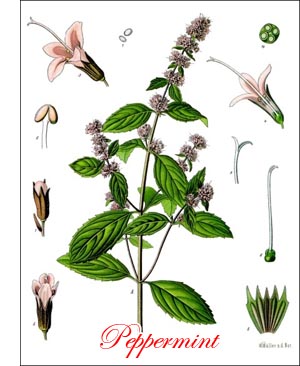Peppermint herb
 Peppermint (Mentha piperita, Linn.) is much the same in habit of growth as the herb spearmint. It is a native of northern Europe, where it may be found in moist situations along stream banks and in waste lands. In America it is probably even more common as an escape than spearmint. Like its relative, it has long been known and grown in gardens and fields, especially in Europe, Asia and the United States.
Peppermint (Mentha piperita, Linn.) is much the same in habit of growth as the herb spearmint. It is a native of northern Europe, where it may be found in moist situations along stream banks and in waste lands. In America it is probably even more common as an escape than spearmint. Like its relative, it has long been known and grown in gardens and fields, especially in Europe, Asia and the United States.Herb Description
Like spearmint, the plant has creeping rootstocks, which rapidly extend it, and often make it a troublesome weed in moist ground. The stems are smaller than those of spearmint, not so tall, and are more purplish. They bear ovate, smooth leaves upon longer stalks than those of spearmint. The whorled clusters of little, reddish-violet flowers form loose, interrupted spikes. No seed is borne.Cultivation
Although peppermint prefers wet, even swampy, soil, it will do well on moist loam. It is cultivated like spearmint. In Michigan, western New York and other parts of the country it is grown commercially upon muck lands for the oil distilled from its leaves and stems. Among essential oils, peppermint ranks first in importance. It is a colorless, yellowish or greenish liquid, with a peculiar, highly penetrating odor and a burning, camphorescent taste.An interesting use is made of it by sanitary engineers, who test the tightness of pipe joints by its aid. It has the faculty of making its escape and betraying the presence of leaks. It is largely employed in the manufacture of soaps and perfumery, but probably its best known use is for flavoring confectionery.
Peppermint herb picture